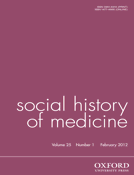-
Views
-
Cite
Cite
Samuel K. Cohn, John Aberth, Plagues in World History, Social History of Medicine, Volume 25, Issue 1, February 2012, Pages 253–254, https://doi.org/10.1093/shm/hkr144
Close - Share Icon Share
Extract
Plagues in World History is divided into six diseases—plague, smallpox, tuberculosis, cholera, influenza, and AIDS, with plague and AIDS filling two-thirds of these chapters' pages. The criteria for selecting the diseases were (1) high mortalities; (2) worldwide diffusion; and (3) ‘a lengthy period’ of historical virulence. Why then were measles, syphilis, typhus, yellow fever, malaria, and others left out, while AIDS was included, when its history for evaluating change in attitudes has to date amounted to a thirty-year blip in the history of human epidemics?
The book strives to be a cultural history of epidemic disease, evaluating the interactions of epidemics with beliefs, politics, social structures, and societal and psychological strains to find how different diseases shape societies in history differently. Best known of such varied outcomes, investigated almost forty years ago by Michael Dols and largely rehearsed here, are the different reactions and historical trajectories set by the Black Death between the Christian West and Muslim Middle East. For the West, plague prompted doctors and rulers towards naturalistic causes of diseases and to experiment with new remedies and laws to protect individuals and societies from pandemics, while the Muslim Middle East remained steadfast in its religious ideology, insisting that human intervention against plague was useless, and worse, a blasphemy against God's will. In our own day, Aberth shows parallel developments with AIDS, especially in Africa and Latin America: how strikingly different levels of this disease's mortality and sereopositivity have depended on beliefs, poverty, and most crucially, the political ideology and ingenuity of its rulers.




